Water Quality of Inflows to the Everglades National Park over Three Decades (1985–2014) Analyzed by Multivariate Statistical Methods
Abstract
1. Introduction
2. Materials and Methods
2.1. Study Area and Data Source
2.2. Seasonal Trend Decomposition Using the Loess (STL) Method
2.3. Cluster Analysis (CA) and Principal Component Analysis (PCA)
3. Results
3.1. Basic Statistics of the Monthly Measured Data at Each Station
3.2. Trend Analysis
3.2.1. DO, pH, and Turbidity
3.2.2. NH4–N, TKN, and TN
3.2.3. PO4–P and TP
3.3. Multivariate Statistical Analysis Results
3.3.1. Cluster Analysis
3.3.2. Principal Component Analysis
4. Discussion
4.1. Linkage of Water Quality Change with Precipitation
4.2. Correlation of Water Quality and Management
4.3. Management Implications
5. Conclusions
Author Contributions
Funding
Acknowledgments
Conflicts of Interest
References
- Entry, J.A. The Impact of Stormwater Treatment and Best Management Practices on Nutrient Concentration in the Florida Everglades. Water Air Soil Pollut. 2014, 225, 1758–1769. [Google Scholar] [CrossRef]
- Chen, H.; Ivanoff, D.; Pietro, K. Long-term phosphorus removal in the Everglades stormwater treatment areas of South Florida in the United States. Ecol. Eng. 2015, 79, 158–168. [Google Scholar] [CrossRef]
- Williams, M.R.; Filoso, S.; Longstaff, B.J.; Dennison, W.C. Long-Term Trends of Water Quality and Biotic Metrics in Chesapeake Bay: 1986 to 2008. Estuaries Coasts 2010, 33, 1279–1299. [Google Scholar] [CrossRef]
- Kauffman, G.J.; Homsey, A.R.; Belden, A.C.; Sanchez, J.R. Water quality trends in the Delaware River Basin (USA) from 1980 to 2005. Environ. Monit. Assess. 2011, 177, 193–225. [Google Scholar] [CrossRef] [PubMed]
- Elci, S.; Selcuk, P. Effects of basin activities and land use on water quality trends in Tahtali Basin, Turkey. Environ. Earth Sci. 2013, 68, 1591–1598. [Google Scholar] [CrossRef]
- Wilcock, R.J.; Monaghan, R.M.; Quinn, J.M. Trends in water quality of five dairy farming streams in response to adoption of best practice and benefits of long-term monitoring at the catchment scale. Mar. Freshw. Res. 2013, 64, 401–412. [Google Scholar] [CrossRef]
- Qian, S.S.; Borsuk, M.E.; Stow, C.A. Seasonal and long-term nutrient trend decomposition along a spatial gradient in the Neuse River watershed. Environ. Sci. Technol. 2000, 34, 4474–4482. [Google Scholar] [CrossRef]
- Liang, Z.Y.; Liu, Y.; Sheng, H.; Yang, Y.H.; Guo, H.C.; Zhao, L.; He, B. Identification of water quality trends in lakes Dianchi using an integrated STL and RSI approach. Acta Sci. Circumst. 2014, 3, 754–762. [Google Scholar]
- Cleveland, R.B.; Cleveland, W.S.; McRae, J.E.; Terpenning, I. STL: A seasonal-trend decomposition procedure based on loess. J. Off. Stat. 1990, 6, 3–33. [Google Scholar]
- Stow, C.A.; Cha, Y.-K.; Johnson, L.T.; Confesor, R.; Richards, R.P. Long-term and seasonal trend decomposition of Maumee River nutrient inputs to Western Lake Erie. Environ. Sci. Technol. 2015, 49, 3392–3400. [Google Scholar] [CrossRef] [PubMed]
- Lee, C.F.; Hsiao, J.H.; Cheng, S.J.; Hsieh, H.H. Identification of regional air pollution characteristic and the correlation with public health in Taiwan. Int. J. Environ. Res. Public Health 2007, 4, 106–110. [Google Scholar] [CrossRef] [PubMed]
- Koklu, R.; Sengorur, B.; Topal, B. Water quality assessment using multivariate statistical methods e a case study Melen River system (Turkey). Water Resour. Manag. 2010, 24, 959–978. [Google Scholar] [CrossRef]
- Hamdan, A.M. Multivariate Statistical Analysis of Geochemical Data of Groundwater in El-Bahariya Oasis, Western Desert, Egypt. Res. J. Environ. Earth Sci. 2012, 4, 665–667. [Google Scholar]
- Xin, X.; Huang, G.; An, C.; Huang, C.; Weger, H.; Zhao, S.; Zhou, Y.; Rosendahl, S. Insights into the Toxicity of Triclosan to Green Microalga Chlorococcum sp. Using Synchrotron-Based Fourier Transform Infrared Spectromicroscopy: Biophysiological Analyses and Roles of Environmental Factors. Environ. Sci. Technol. 2018, 52, 2295–2306. [Google Scholar] [CrossRef] [PubMed]
- Hanlon, E.A.; Fan, X.H.; Gu, B.; Migliaccio, K.W.; Li, Y.C.; Dreschel, T.W. Water Quality Trends at Inflows to Everglades National Park, 1977–2005. J. Environ. Qual. 2010, 39, 1724–1733. [Google Scholar] [CrossRef] [PubMed]
- Fan, X.; Gu, B.; Hanlon, E.A.; Li, Y.; Migliaccio, K.; Dreschel, T.W. Investigation of long-term trends in selected physical and chemical parameters of inflows to Everglades National Park, 1977–2005. Environ. Monit. Assess. 2011, 178, 525–536. [Google Scholar] [CrossRef] [PubMed]
- Hafen, R.P.; Anderson, D.E.; Cleveland, W.S.; Maciejewski, R.; Ebert, D.S.; Abusalah, A.; Yakout, M.; Ouzzani, M.; Grannis, S. Syndromic surveillance: STL for modeling, visualizing, and monitoring disease counts. BMC Med. Inform. Decis. Mak. 2009, 9, 1–11. [Google Scholar] [CrossRef] [PubMed]
- APHA. Standard Methods for the Examination of Water and Wastewater, 20th ed.; American Public Health Association, American Water Works Association and Water Pollution Control Federation: Washington, DC, USA, 1998. [Google Scholar]
- Zhou, J.; Liang, Z.; Liu, Y.; Guo, H.C.; He, D.; Zhao, L. Six-decade temporal change and seasonal decomposition of climate variables in Lake Dianchi watershed (China): Stable trend or abrupt shift? Theory Appl. Climatol. 2015, 119, 181–191. [Google Scholar] [CrossRef]
- Giridharan, L.; Venugopal, T.; Jayaprakash, M. Assessment of water quality using chemometric tools: A case study of river Cooum, South India. Arch. Environ. Contam. Toxicol. 2009, 56, 654–669. [Google Scholar] [CrossRef] [PubMed]
- Lu, X.; Wang, L.; Li, L.Y.; Lei, K.; Huang, L.; Kang, D. Multivariate statistical analysis of heavy metals in street dust of Baoji, NW China. J. Hazard. Mater. 2010, 173, 744–749. [Google Scholar] [CrossRef] [PubMed]
- USEPA. Ambient Water Quality Criteria Recommendations: Information Supporting the Development of State and Tribal Nutrient Criteria, Lakes, and Reservoirs in Nutrient Ecoregion XIII; USEPA Office of Water: Washington, DC, USA, 2000. [Google Scholar]
- Green, C.T.; Bekins, B.A.; Kalkhoff, S.J.; Hirsch, R.M.; Liao, L.; Barnes, K.K. Decadal surface water quality trends under variable climate, land use, and hydrogeochemical setting in Iowa, USA. Water Resour. Res. 2014, 50, 2425–2443. [Google Scholar] [CrossRef]
- Guan, K.; Thompson, S.E.; Harman, C.J.; Basu, N.B.; Rao, P.S.C.; Sivapalan, M.; Packman, A.I.; Kalita, P.K. Spatiotemporal scaling of hydrological and agrochemical export dynamics in a tile-drained Midwestern watershed. Water Resour. Res. 2011, 47, W00J02. [Google Scholar] [CrossRef]
- Xin, X.; Li, K.; Finlayson, B.; Yin, W. Evaluation, prediction, and protection of water quality in Danjiangkou Reservoir, China. Water Sci. Eng. 2015, 8, 30–39. [Google Scholar] [CrossRef]
- Qian, Y.; Migliaccio, K.W.; Wan, Y.S.; Li, Y.C. Trend Analysis of Nutrient Concentrations and Loads in Selected Canals of the Southern Indian River Lagoon, Florida. Water Air Soil Pollut. 2007, 186, 195–208. [Google Scholar] [CrossRef]
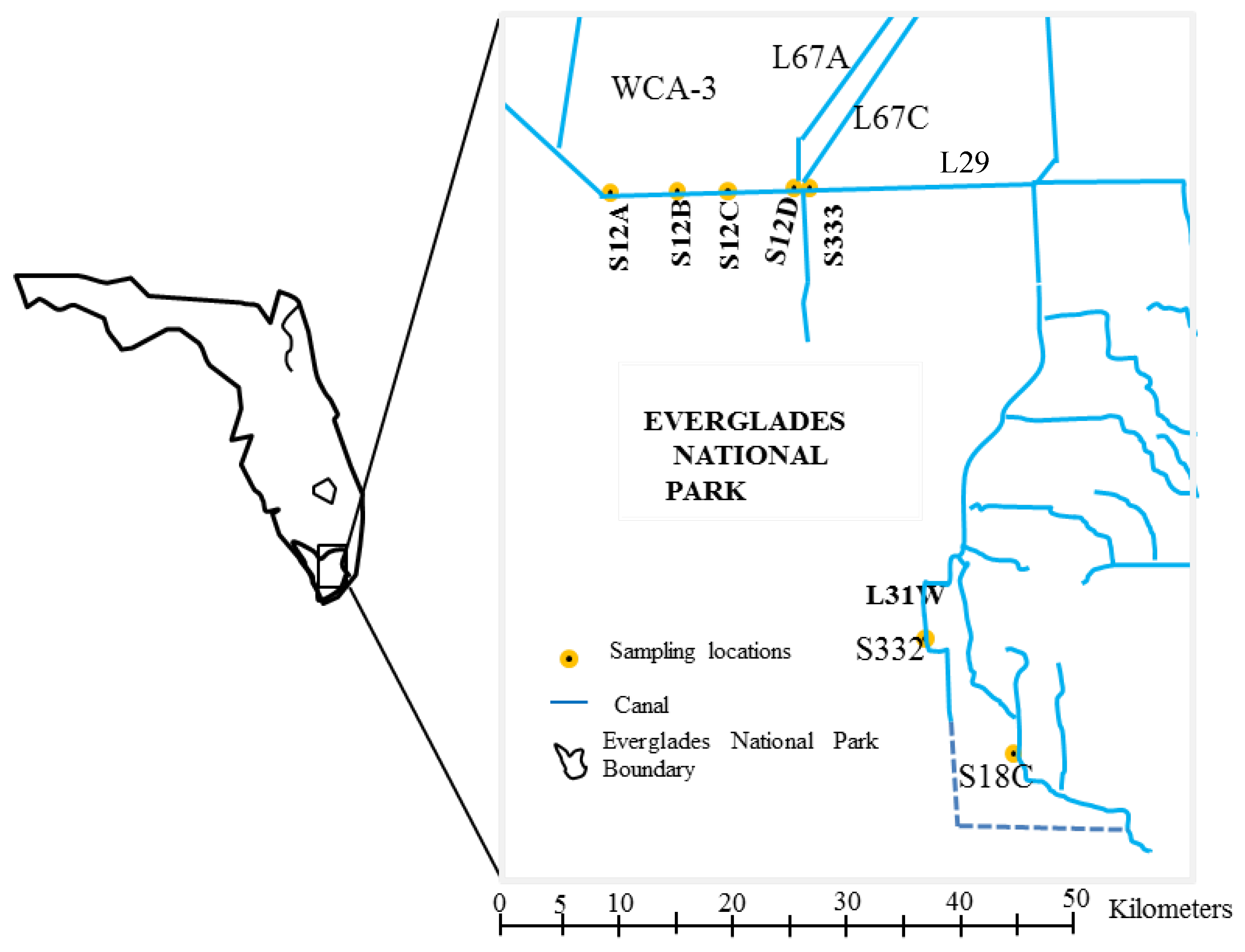
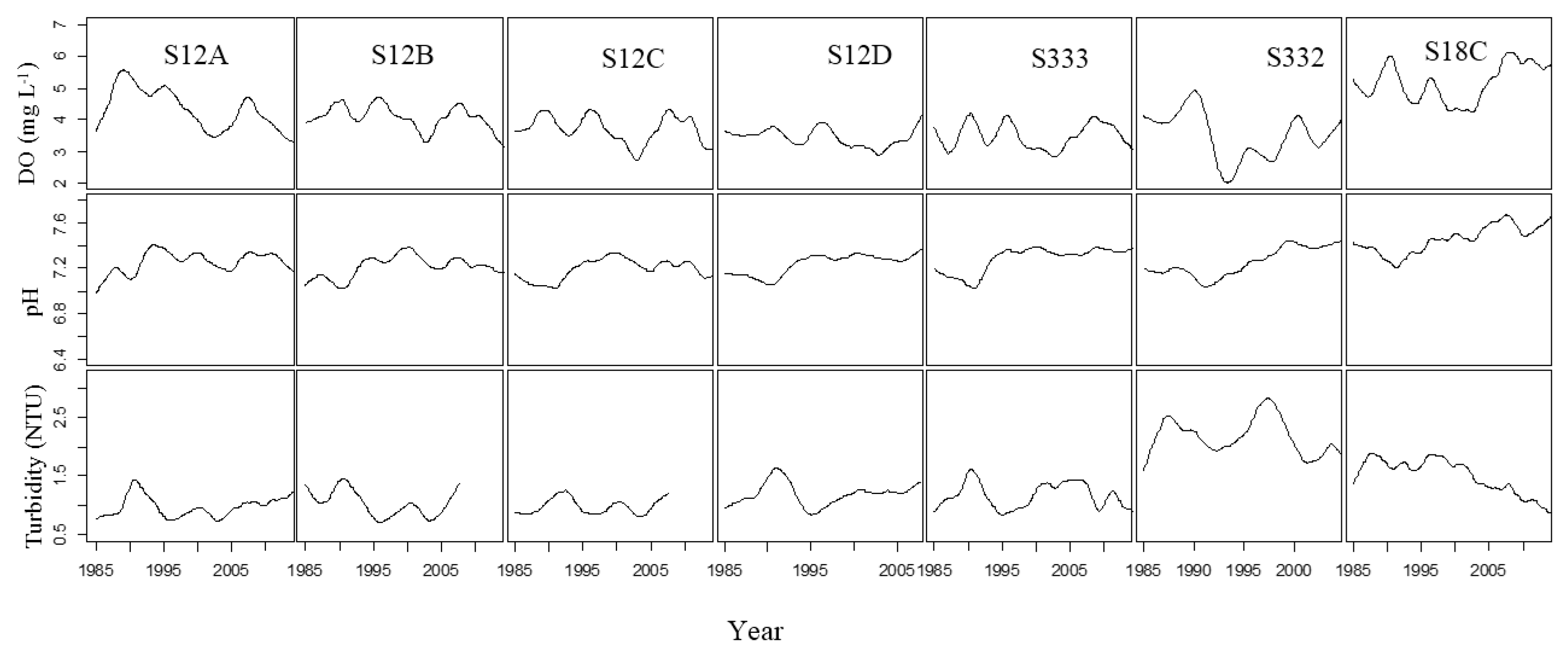
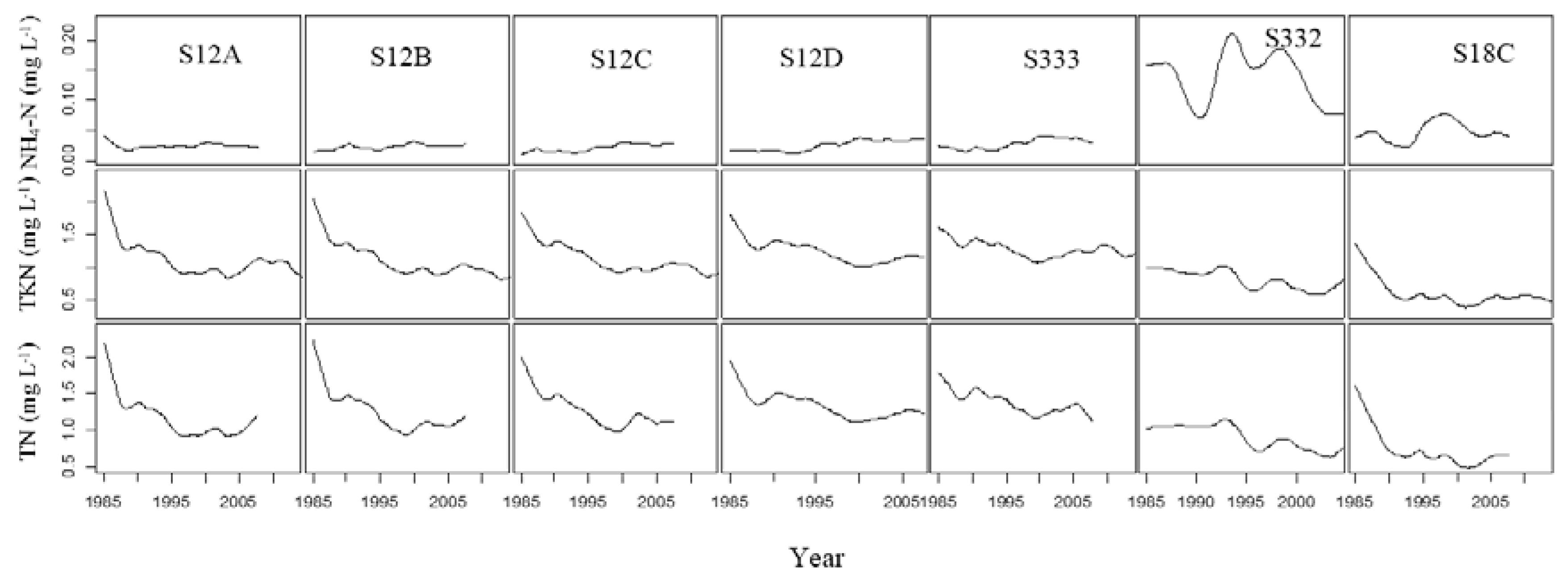
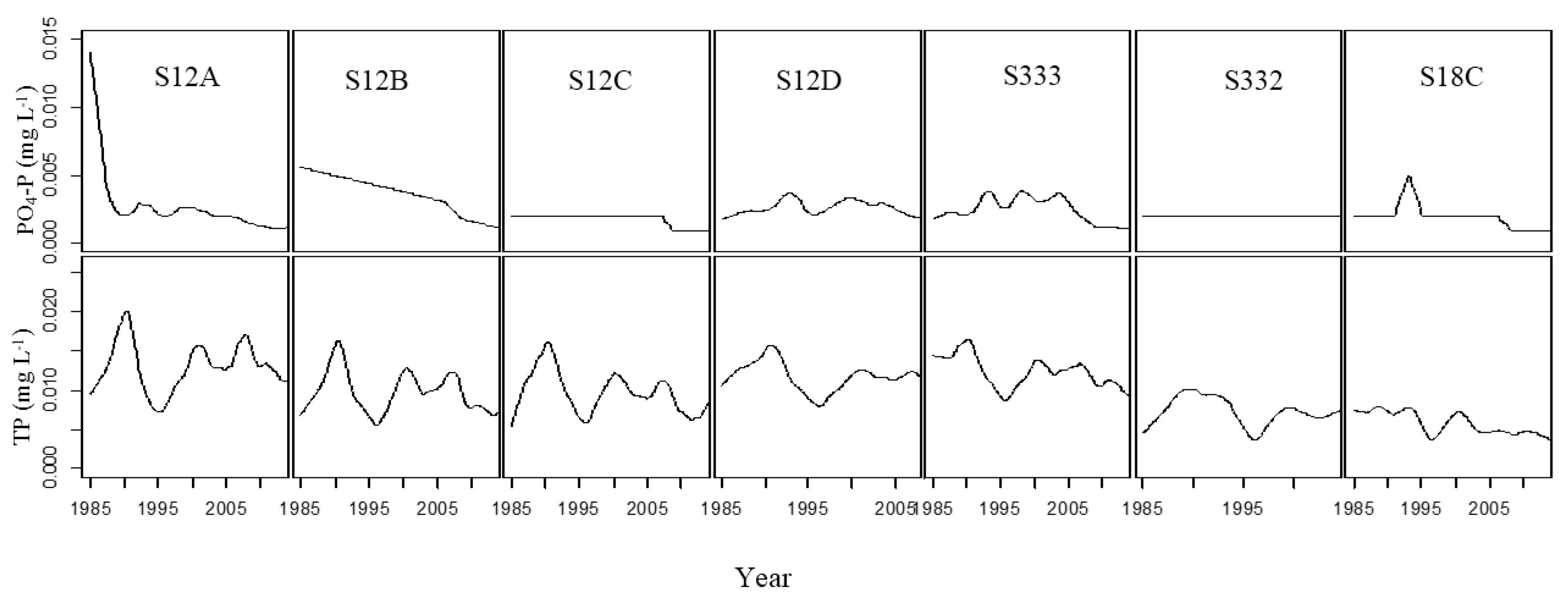

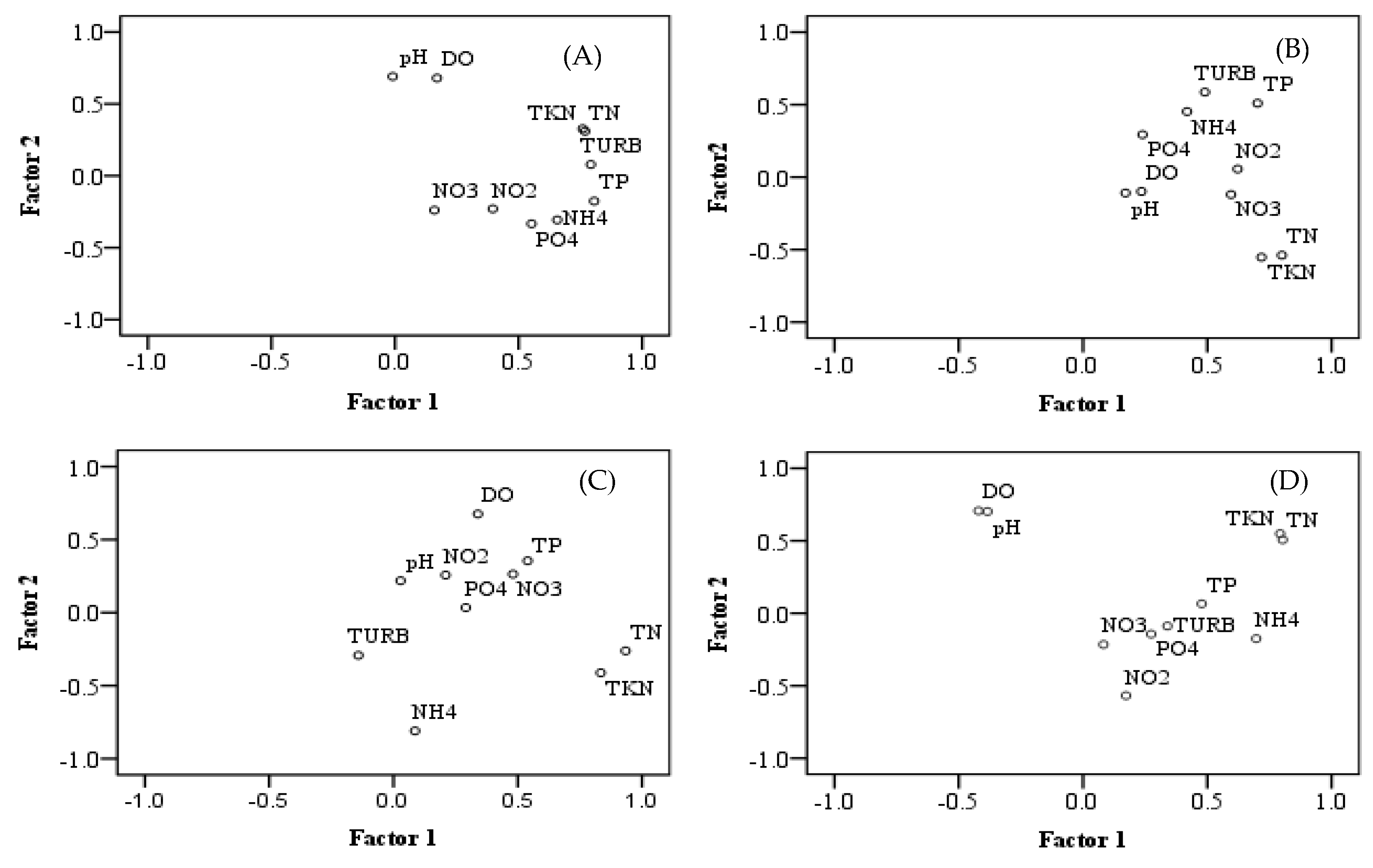
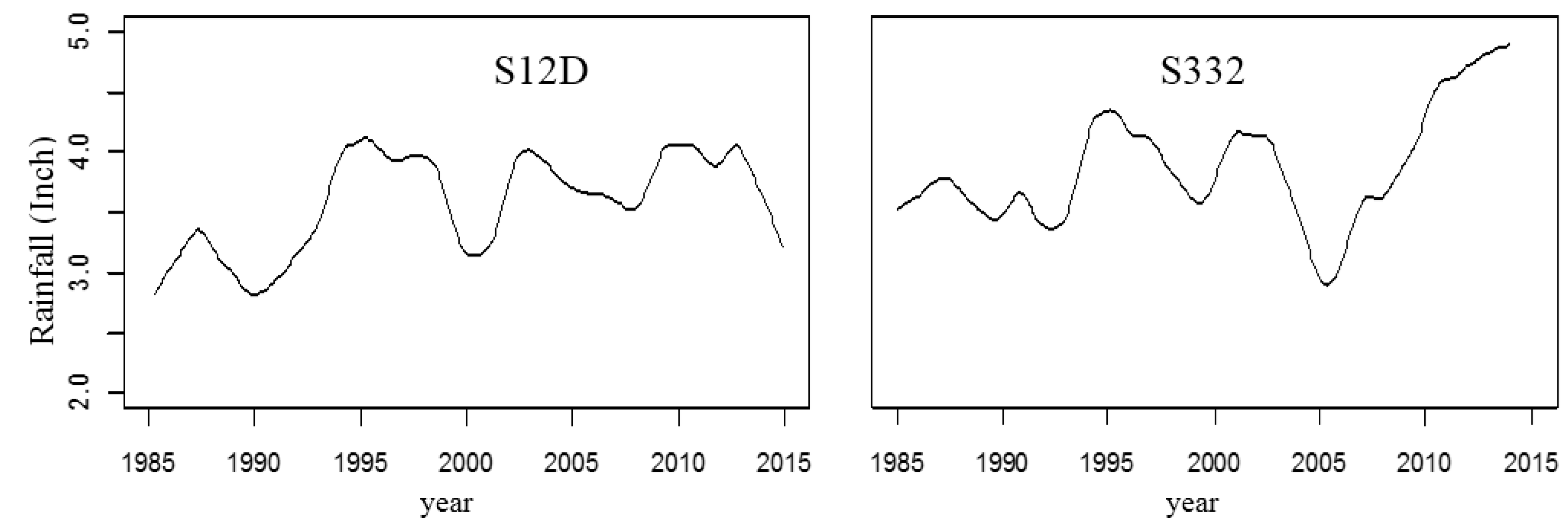

| Water Quality Parameter | Detection Limit * | Analytical Method # |
|---|---|---|
| DO | 0.1 mg/L | EPA 360.1 |
| pH | - | EPA 150.1 |
| Turbidity | 0.1 NTU @ | SM 2130B |
| NH4–N | 0.008 mg/L | SM 4500-NH3H |
| NOX–N | 0.004 mg/L | SM 4500NO3F |
| TKN | 0.05 mg/L | EPA 351.2 |
| PO4–P | 0.002 mg/L | SM4500PF |
| TP | 0.002 mg/L | SM 4500PF |
| Parameters | S12A | S12B | S12C | S12D | S333 | S332 | S18C | |
|---|---|---|---|---|---|---|---|---|
| DO (mg L−1) | Max | 15.4 | 11.6 | 8.4 | 14 | 8.1 | 8.5 | 11.4 |
| Min | 0.20 | 0.17 | 0.29 | 0.2 | 0.3 | 0.1 | 0.6 | |
| Mean | 4.40 | 5.79 | 3.89 | 3.70 | 3.59 | 3.42 | 5.17 | |
| SD | 1.65 | 1.72 | 1.57 | 1.66 | 1.47 | 1.95 | 1.47 | |
| pH | Max | 9.71 | 8.95 | 9.26 | 8.85 | 8.52 | 8.76 | 8.89 |
| Min | 5.80 | 5.90 | 5.80 | 5.90 | 6.00 | 6.00 | 5.35 | |
| Mean | 7.26 | 7.22 | 7.19 | 7.26 | 7.28 | 7.28 | 7.45 | |
| SD | 0.30 | 0.40 | 0.29 | 0.31 | 0.27 | 0.37 | 0.27 | |
| Turbidity (NTU) | Max | 11.60 | 16.40 | 9.10 | 12.80 | 20.00 | 15.00 | 25.00 |
| Min | 0.10 | 0.05 | 0.1 | 0.2 | 0.3 | 0.69 | 0.44 | |
| Mean | 1.51 | 1.44 | 1.37 | 1.63 | 1.7 | 2.57 | 1.82 | |
| SD | 1.45 | 1.19 | 1.06 | 1.53 | 1.92 | 1.76 | 1.92 | |
| NH4–N (mg L−1) | Max | 1.00 | 1.36 | 0.65 | 0.49 | 0.35 | 0.5 | 0.49 |
| Min | 0.003 | 0.003 | 0.005 | 0.005 | 0.005 | 0.005 | 0.005 | |
| Mean | 0.048 | 0.053 | 0.041 | 0.044 | 0.042 | 0.145 | 0.027 | |
| SD | 0.087 | 0.099 | 0.061 | 0.060 | 0.049 | 0.098 | 0.049 | |
| TKN (mg L−1) | Max | 7.80 | 2.81 | 3.52 | 3.21 | 3.88 | 2.36 | 2.78 |
| Min | 0.025 | 0.25 | 0.57 | 0.65 | 0.025 | 0.25 | 0.025 | |
| Mean | 1.14 | 1.15 | 1.17 | 1.30 | 1.34 | 0.84 | 0.67 | |
| SD | 0.55 | 0.52 | 0.51 | 0.32 | 0.33 | 0.36 | 0.33 | |
| Total nitrogen (TN) (mg L−1) | Max | 7.85 | 2.81 | 3.53 | 4.4 | 5.25 | 3.28 | 2.95 |
| Min | 0.11 | 0.25 | 0.59 | 0.73 | 0.79 | 0.26 | 0.25 | |
| Mean | 1.20 | 1.25 | 1.29 | 1.37 | 1.44 | 0.92 | 0.76 | |
| S.D | 0.59 | 0.59 | 0.40 | 0.36 | 0.41 | 0.41 | 0.41 | |
| PO4–P (mg L−1) | Max | 0.062 | 0.057 | 0.134 | 0.037 | 0.037 | 0.02 | 0.017 |
| Min | 0.001 | 0.001 | 0.001 | 0.001 | 0.001 | 0.002 | 0.001 | |
| Mean | 0.0037 | 0.0035 | 0.0038 | 0.0044 | 0.0038 | 0.0030 | 0.0026 | |
| SD | 0.0040 | 0.030 | 0.0086 | 0.0049 | 0.0046 | 0.0023 | 0.0046 | |
| TP (mg L−1) | Max | 0.25 | 0.48 | 0.13 | 0.068 | 0.093 | 0.057 | 0.056 |
| Min | 0.001 | 0.002 | 0.001 | 0.002 | 0.001 | 0.002 | 0.001 | |
| Mean | 0.021 | 0.017 | 0.013 | 0.014 | 0.015 | 0.0085 | 0.0072 | |
| SD | 0.14 | 0.094 | 0.015 | 0.0098 | 0.011 | 0.0062 | 0.011 |
| Water Quality | DO | pH | Turbidity | NO3–N | NO2–N | NH4–N | TKN | PO4–P | TN | |
|---|---|---|---|---|---|---|---|---|---|---|
| S12D | Pearson Correlation | −0.202 ** | 0.089 | 0.066 | 0.014 | 0.138 * | −0.080 | −0.030 | 0.048 | −0.021 |
| Sig. (two-tailed) | 0.001 | 0.147 | 0.282 | 0.822 | 0.023 | 0.192 | 0.621 | 0.434 | 0.728 | |
| S332 | Pearson Correlation | −0.292 ** | −0.121 | 0.158 * | −0.032 | 0.050 | −0.003 | −0.141 * | 0.001 | −0.137 * |
| Sig. (two-tailed) | 0.000 | 0.055 | 0.012 | 0.611 | 0.430 | 0.966 | 0.026 | 0.988 | 0.030 | |
© 2018 by the authors. Licensee MDPI, Basel, Switzerland. This article is an open access article distributed under the terms and conditions of the Creative Commons Attribution (CC BY) license (http://creativecommons.org/licenses/by/4.0/).
Share and Cite
Wan, L.; Fan, X. Water Quality of Inflows to the Everglades National Park over Three Decades (1985–2014) Analyzed by Multivariate Statistical Methods. Int. J. Environ. Res. Public Health 2018, 15, 1882. https://doi.org/10.3390/ijerph15091882
Wan L, Fan X. Water Quality of Inflows to the Everglades National Park over Three Decades (1985–2014) Analyzed by Multivariate Statistical Methods. International Journal of Environmental Research and Public Health. 2018; 15(9):1882. https://doi.org/10.3390/ijerph15091882
Chicago/Turabian StyleWan, Lei, and Xiaohui Fan. 2018. "Water Quality of Inflows to the Everglades National Park over Three Decades (1985–2014) Analyzed by Multivariate Statistical Methods" International Journal of Environmental Research and Public Health 15, no. 9: 1882. https://doi.org/10.3390/ijerph15091882
APA StyleWan, L., & Fan, X. (2018). Water Quality of Inflows to the Everglades National Park over Three Decades (1985–2014) Analyzed by Multivariate Statistical Methods. International Journal of Environmental Research and Public Health, 15(9), 1882. https://doi.org/10.3390/ijerph15091882





